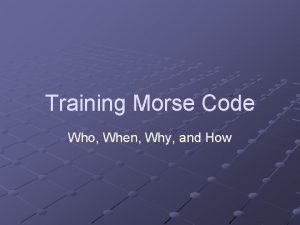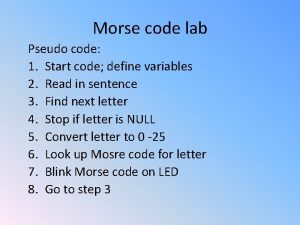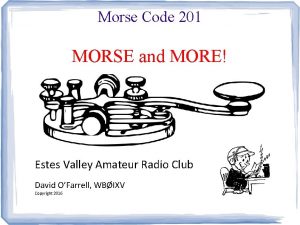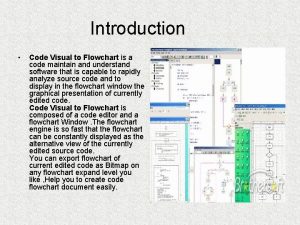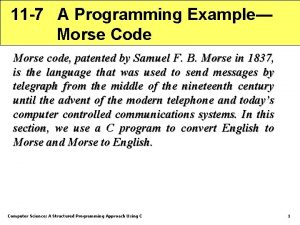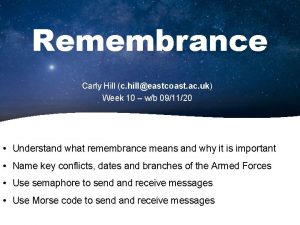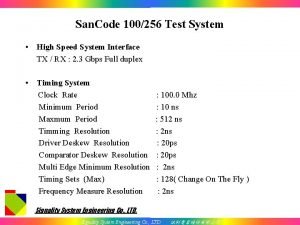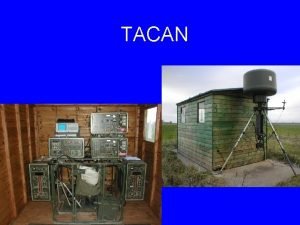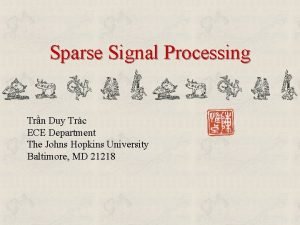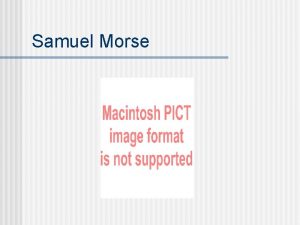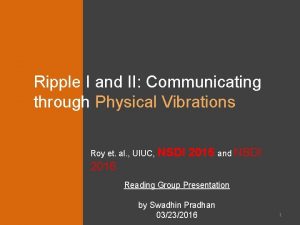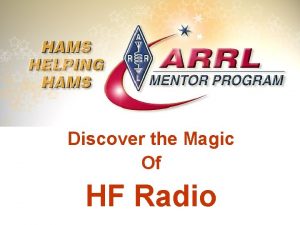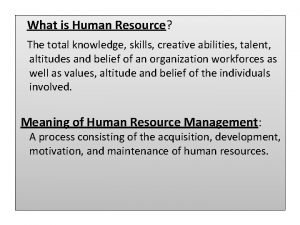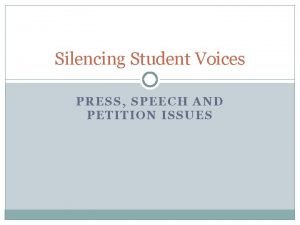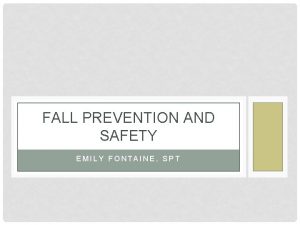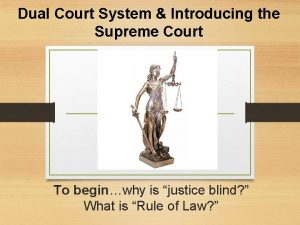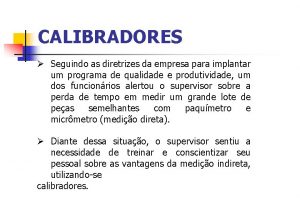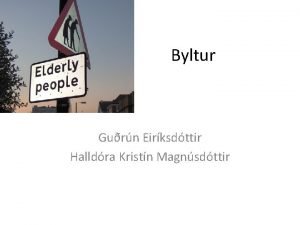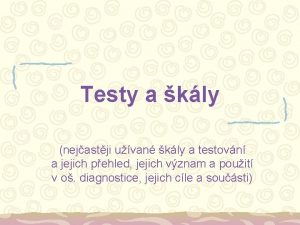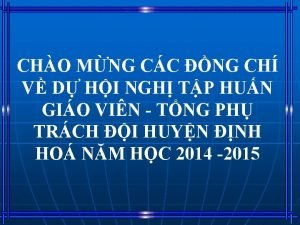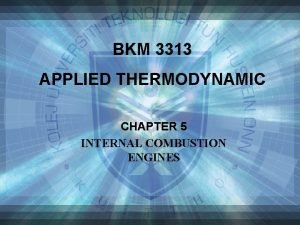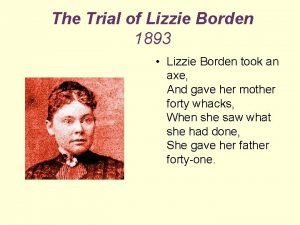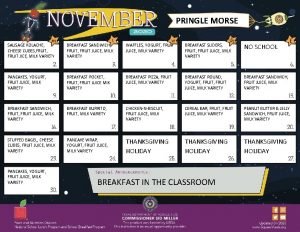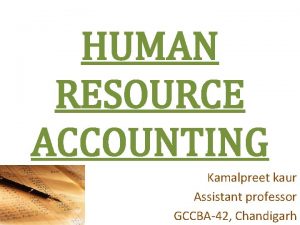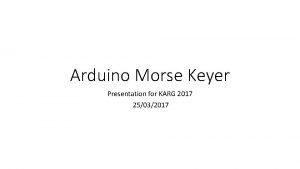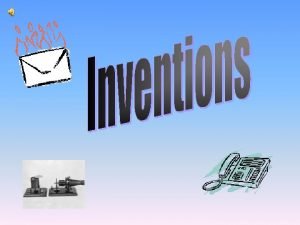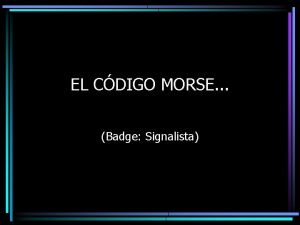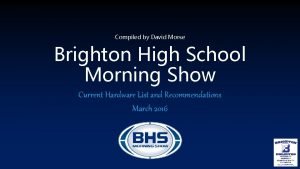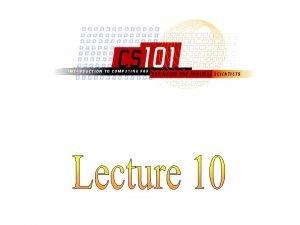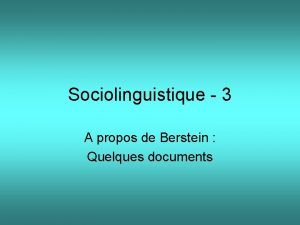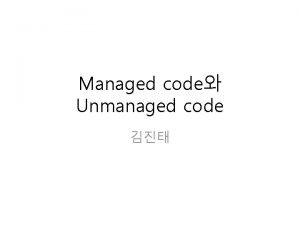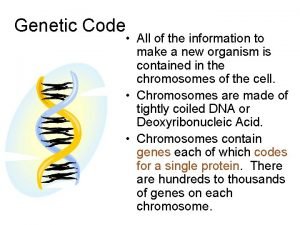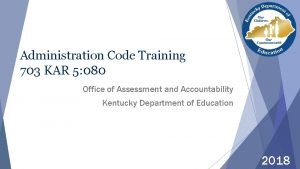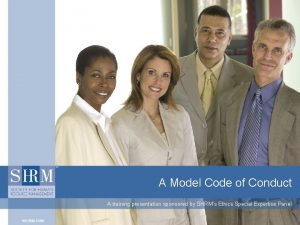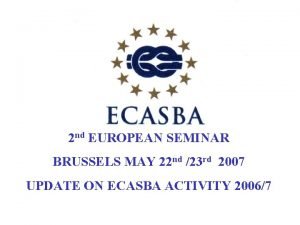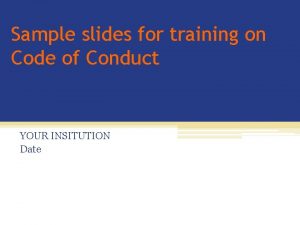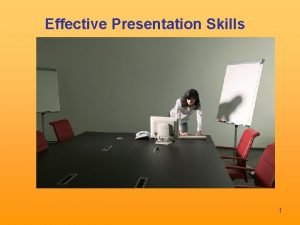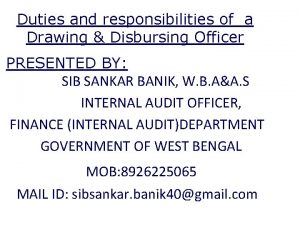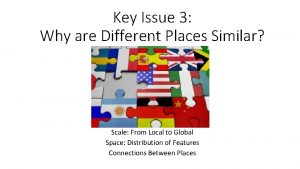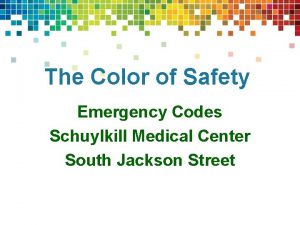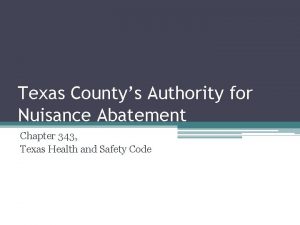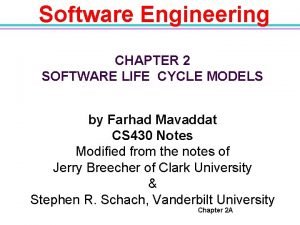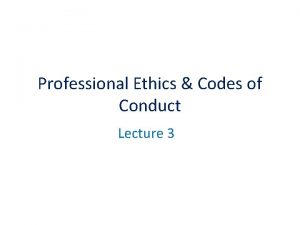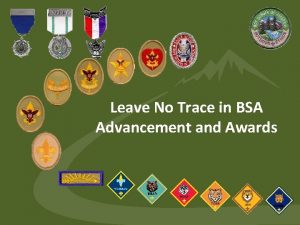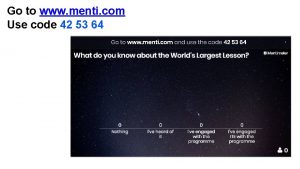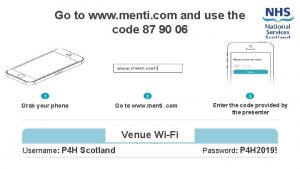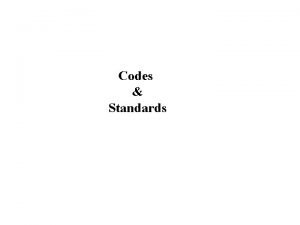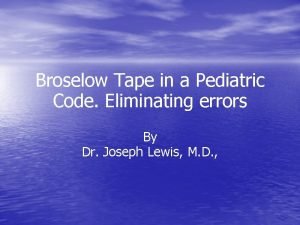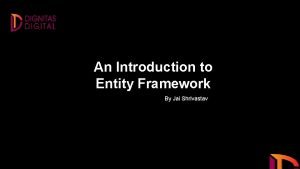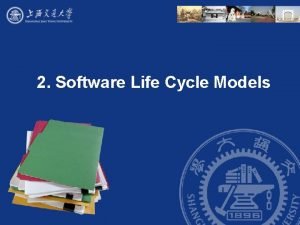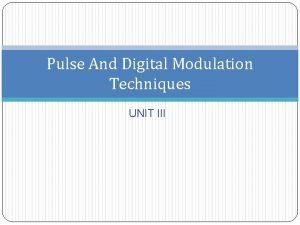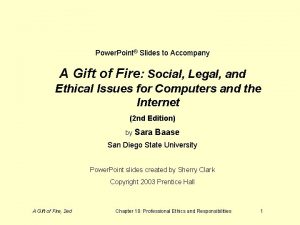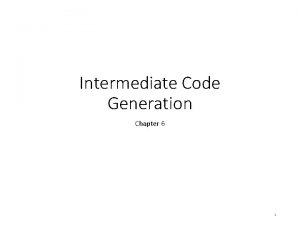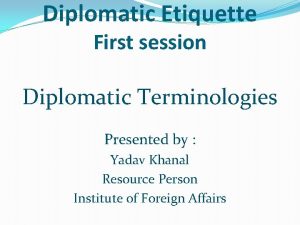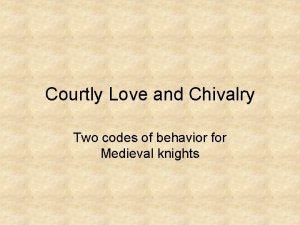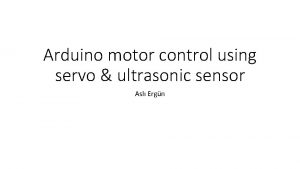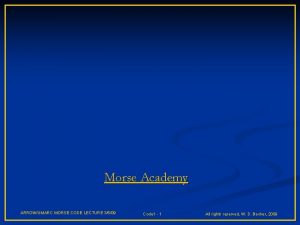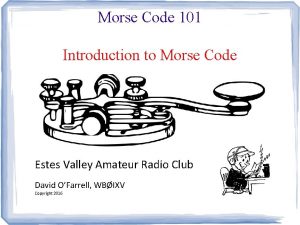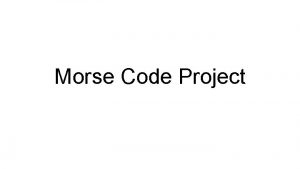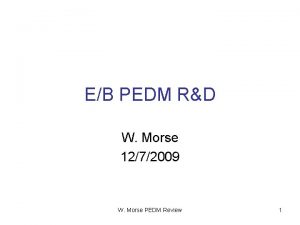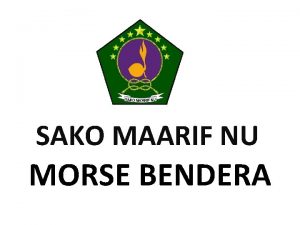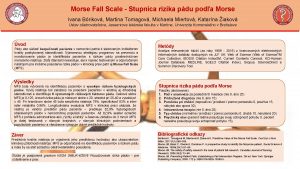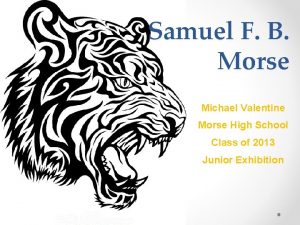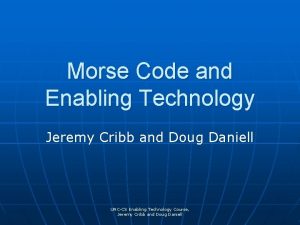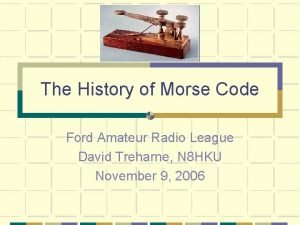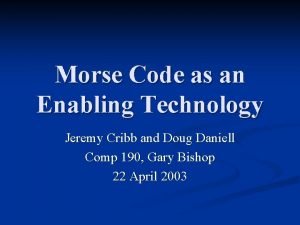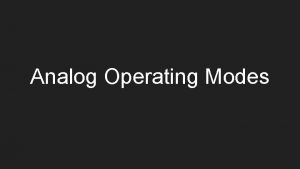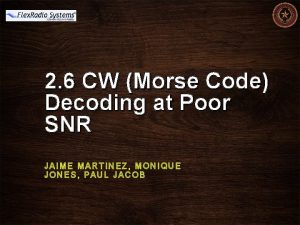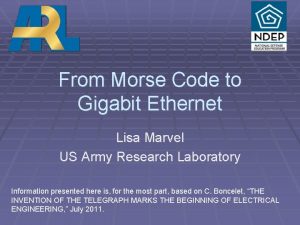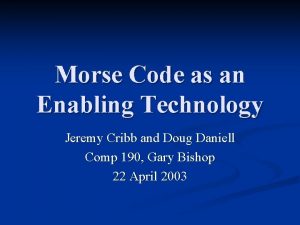Training Morse Code Who When Why and How







































































































- Slides: 103

Training Morse Code Who, When, Why, and How

What is Morse Code? Most people are familiar with the general concept of Morse Code n It is a method of communicating that is composed of two “symbols” Dit – spelled “*” Dah – Spelled “-” n But just what are these symbols?

What is Morse Code? Tom King, from the University of Wisconsin – Eau Claire refers to Morse as a “language” n n Languages are “words, methods of combining them used and understood by a community. Morse does not properly fit this definition, since the words used are the same as in the enclosing language

What is Morse Code? Morse may be thought of as an alphabet n n Alphabets are sets signs or symbols used as equivalents for letters Morse symbols are used to spell letters in order to form words in the English language.

Language Representation Written languages are a trade-off between the amount of information conveyed in a single symbol and the number of symbols that must be used.

Language Representation Information theory says that information is derived from the amount of uncertainty in a situation. n n When there are many options, there is a great deal of uncertainty in the situation, and each symbol contains more information. When there are only a few options, each symbol conveys less information, because there is less uncertainty

Language Representation Using this model, Chinese pictograms contain a great deal of information, because there are so many of them n An educated Mandarin must know around 7000 symbols

Language Representation European alphabets contain between 20 and 30 symbols n each symbol conveys a moderate amount of information

Language Representation Morse Code contains only two symbols n Each symbol conveys very little information.

Language Representation The number of symbols required to convey a concept varies inversely with the information carried by each symbol n n n In Mandarin, many concepts can be expressed in a single symbol, resulting in a compact language In English, the average word length is around 5 symbols In Morse, the average word is around 15 symbols long

Language Representation The number of symbols must be balanced against the difficulty of creating a single symbol n In Mandarin, symbols are sometimes very complex, and changes in strokes can change the meaning

Language Representation In English, each symbol is easier to make, but more must be used

Language Representation In Morse, each symbol is very easy to use, but more must be used to convey information. n n Originally, the Morse symbols were designed for easy transmission with primitive communications technology For computers, it is the easy of creating symbols that makes Morse a desirable method of generating text.

Language Representation In addition to being the Morse alphabet being easy to produce, the Words of the Morse language (letters in English) have spellings that are based on how frequently they are used.

Language Representation When Morse originally created his code, he recognized that some letters (e & t for example) are used much more often that others (Q and Z for example)

Language Representation He assigned the shortest codes to the most frequently used letters, so that overall productivity goes up.

Language Representation For example, Dickens’ “American Notes” contains 352, 406 letters n n In un-optimized code, this would result in 1, 111, 434 symbols to generate in Morse In actual Morse, the novel could be written with 893, 266 symbols, for a savings of about 20%!

Language Representation Several features of Morse would make this task even easier that it seems: n For two-switch Morse, multiple symbols (a row of dits or dahs) can be generated with a single switch activation

Who Should Use Morse? Within the access hierarchy, anyone who can access a physical keyboard with fluency will find it faster or easier than Morse n This includes Expanded Keyboards Standard keyboards Minikeyboards

Who Should Use Morse? With modern technology, in an environment that supports it, speech input will generally be faster, but not easier than Morse n n n The client must have consistent speech and good breath support The client must have good cognition (better than that required for Morse) The client be in an environment where constant talking will not distract others

Who Should Use Morse? A person who has difficulty with new learning may find Morse difficult to remember, and should use an input method with fewer cognitive demands n n On-screen keyboards draw on old learning, when available On-screen keyboards show all options at once, so may be easier for many people than Morse

Who Should Use Morse? The person with only a single motor site, and without the ability to performed times movements will not be able to use Morse

Who Should Use Morse? So, who is left? n n n Clients with limited ROM and/or limited fine motor control Clients with ability to learn new concepts Clients with “good” thinking skills Able to read at 3 rd grade level Note: This may be a conservative standard!

Who Should Use Morse? Conventional thinking about Morse Code considers it only for language applications n n n Morse can also be used in leisure and EADL applications Even the client who cannot learn Morse with the fluency to write can learn enough Morse for some leisure and environmental control applications. This is a valid application, even if some other tool must be used for writing!

Why use Morse? It’s fast! n n Typical users using sip & puff switches may reach typing speeds of 20 to 25 words per minute Compare this with typical on-screen keyboard speeds of 15 to 20 wpm!

Why use Morse? It is transparent n Nearly all input methods for people with disabilities require a degree of attention This can be termed “cognitive overhead” It is mental power that is not available to the task at hand. n Proficient users of Morse Code say that “they” do not know the code. They just think words, and they appear on the screen. This is similar to the process of touch typing, where your fingers know the keys.

Why use Morse? Morse code can be completely automatic n This means that there is virtually no cognitive overhead once it is learned.

Isn’t Morse Hard to Learn? Learning Morse Code is like learning to touch type, as opposed to “hunt and peck” techniques like on-screen keyboards n n n There is a certain amount of work that goes into learning to touch type When you first start learning, it seems very difficult, and slower than hunt-and-peck typing You have to learn a lot before you even start!

Isn’t Morse Hard to Learn? Once you have learned to touch type, almost no-one goes back to hunt-and-peck typing n n n This is because it is actually easier (once learned) It is faster It is more efficient

Isn’t Morse Hard to Learn? Like Touch Typing, learning Morse Code is an investment in the client’s future. n Once the time and energy is invested, it will be paid back many times over, for the rest of the client’s life!

How hard is Morse? Many clinicians in school system practice will say that they would not consider teaching Morse to a young child because it is too difficult. They would allow the child to use a less efficient method until fourth or fifth grade, then consider changing to Morse

How hard is Morse? In the first four or five years, the child has learned to become frustrated at the difficulty of writing!

How hard is Morse? But, consider: n n n Developmentally, children first learn to “scribble” Next they learn to produce horizontal lines Next, they learn to scribble vertical lines Next they learn crosses Finally, they learn diagonals.

How hard is Morse? Now, consider the process in teaching a child to generate the character “A” n n n First, the child must make a diagonal stroke Next, the child must make a matching diagonal stroke, touching at the top! Finally, the child must make a horizontal stroke, starting at one diagonal, ending at the other.

How hard is Morse? Compare this to the process for making an “A” using Morse code, with two switches n n First, the child presses and releases one switch Next the child presses and releases the second switch

How hard is Morse? Yet, we feel that the first is a reasonable activity for the child in kindergarten, and the second is too hard!

How hard is Morse? There are, of course, some differences: n In written language, the movement pattern “looks” like the letter to be produced. This supports eye-hand coordination n In Morse, the movement pattern doesn’t resemble the desired outcome. This is similar to the issues of keyboarding, where the movement patterns are not like the letters produced. But, again, we start children keyboarding in the first grade, and think Morse is too hard!

How hard is Morse? I suggest that Morse should be started, for the child with significant disabilities, at the same age that typically developing children are learning to make letters with a pencil! n n This avoids learned helplessness It also allows the child the maximum opportunities to participate in the curriculum.

Morse and Timing The standard Morse definition for single switch Morse code is that: n n n A dit is the basic unit of measure, and each sender may have a different dit length A “dah” is three dits long. That is, to produce a “dah”, the switch must be held down three times as long as for a dit. The space between parts of a letter is one dit The space between letters is 1 dah The space between words is 7 dits

Morse and Timing Note that this is for radio Morse, which doesn’t have characters for spaces In computer Morse, the space for end of letter is five dits (generally), and words are separated by space characters

Morse and Timing For two switch Morse, dits and dahs can be the same length of switch closure, since there is no ambiguity about which switch was pressed. But, for both one and two switch Morse, the sender must be able to produce switch closures at a repeatable rate.

Morse and Timing If the client cannot produce switch closures with repeatable timing, then one and two-switch Morse are not options For this client, you can use three switch Morse, which removes the need for timing!

Morse and Sound Virtually all Morse code products for computer access generate tones when a switch is closed.

Morse and Sound This tone, called a “side tone, ” is vital to the learning of Morse

Morse and Sound In some settings, where the noise may be a distraction, some might be tempted to turn it off. n n Don’t do it! If the environment won’t tolerate the sound of the side -tone, provide the user with earphones so that the sound doesn’t distract others, but is available to the sender. The sound is essential because the user learns code as sound patterns, or tunes. n Without the tunes, code is much harder to learn.

Computer Morse Vs. Radio Morse In 1980, Al Ross, at the University of Washington created a communication system using Morse Code This code was later included in the Adaptive Firmware Card, for the Apple II computer

Computer Morse Vs. Radio Morse When code was being used for communication via electronic devices, some additions were necessary n n Standard Morse includes the letters, numbers, period, end of work, and end of message codes For computers, you need some additional codes, for punctuation, shift keys, and such

Computer Morse Vs. Radio Morse To add then necessary codes, Al used the unassigned codes, and arbitrarily gave them meanings n There was no effort to optimize these codes, because the relative frequency of “%” versus “&” is generally unimportant

Computer Morse Vs. Radio Morse Each subsequent developer of a Morse product used the same technique (random assignment) to extend standard Morse As a result, each Morse product has slightly different codes for the extension characters

Computer Morse Vs. Radio Morse To help manage this chaos, Morse 2000 Outreach published a “standard computer Morse” definition in the hopes that future developers would use the standard, and order could be imposed

Computer Morse Vs. Radio Morse For now, it is vital that clients be trained on the version of Morse that will be used in the classroom n Note: some products allow Morse to be defined, so that different standards can be trained on the same product, within limits

Sending Vs. Receiving Most of the information available about Morse training comes from ham radio operators n In order to have an advanced ham license, the operator must be able to send Morse in excess of 13 wpm.

Sending Vs. Receiving Much of this information also focuses on “receiving” Morse, rather than sending it n Recognition of Morse is nearly as important for computer access as it is for Ham radio operators.

Sending Vs. Receiving Morse Code is not “perceived” as individual elements by experienced users, it is perceived as tunes. n This is important for the process of learning as well as the process of sending

Sending Vs. Receiving A person who is trying to learn Morse code should practice tune recognition as well as switch operation. This “tune recognition” will become important when we discuss training techniques n Tunes, when played at different speeds, may not be recognizable as the same.

Character Speed Vs Word Speed When we talk about Morse training, we usually talk about the “words per minute” being typed

Character Speed Vs Word Speed There actually two rates that must be considered in Morse training n n Rate at which an individual character is generated Rate at which a string of characters is generated Each of these rates is important, but in different ways

The Farnsworth Method The Farnsworth method was developed to teach Morse to radio operators, but applies equally well (perhaps better) for computer users. In this method, the characters are learned at a rate that matches the ultimate sending goal (arbitrarily set at 18 WPM), with extended spacing between letters

The Farnsworth Method This is used because of what we know about “tune recognition” n n n At different speeds, tunes may not be recognized as the same When a tune is learned at a slow speed, it is very difficult to speed it up So, it’s better to learn the “tunes” at the rate at which they will be used.

The Farnsworth Method was developed for able-bodied radio operators. How can we adapt it for clients with limited motor skills?

Adapted Farnsworth Step one – Can the client use two switches reliably? n n n This must be assessed carefully. Are there two functional motor sites that do not interfer with other activities? Must be able to activate in isolation Must be able to activate repeatedly Must be able to activate over long periods of time

Adapted Farnsworth Can the client activate these motor sites at a consistent rate? n n n You might need to evaluate this using a metronome or other ticker For some clients, activating the site may produce motor overflow that is of variable duration Connect the switch to a beeper, then have the client keep time with the metronome

Adapted Farnsworth After the sites are tested in isolation, try them together n Again, with a metronome, have the client activate one switch on “tick” and the second on “tock”

Adapted Farnsworth If the client cannot keep time with the metronome at any speed, you will need to consider three switch Morse n Try to find a third switch site that can be used separately from the previous two, then skip ahead

Adapted Farnsworth Establish a switch rate n n Once the client can keep time with the metronome, accelerate the rate slowly Try to find the highest rate at which the client is able to keep time with the metronome This will be the target rate for sending Morse code Note that we have not even looked at code yet!

Adapted Farnsworth To convert ticks to words per minute: n The “standard word” for Morse Code is “Paris” This word is standard because it has the average number of letters per word, and the average number of Morse elements per word. n n “Paris” is 50 ticks long Divide the “beats per minute” that the client can match with the metronome and divide by 50 to find the target words per minute

Adapted Farnsworth Use this rate, from the beginning, as the “character send rate. ” n The character send rate determines the timing of elements within a single character, and is separate from the timing between characters in a word

Adapted Farnsworth Depending on the Morse product, you will need to adjust the “valid switch delay” setting to this target rate Once this rate is established, the client will use the spacing for all Morse training, even from the very beginning

Learning the Codes The general pattern for learning Morse code, as used by radio operators, is to learn the letters that are related There are two different approaches that are commonly used n n Visual Auditory

Learning Code Visually The key concept here is that codes are represented by images that help to remember the codes Several systems exist We’ll look at two

Stoney Creek Morse Code Image Cue ONE DOT: (letter E) O--| |--- Think of the dot in the upper left hand corner of the E.

Stoney Creek Morse Code Image TWO DOTS: /----- | O | (letter I) -----/ Cue Think of two human eyes (hence, the letter I). the pupils are the dots.

Stoney Creek Morse Code Image Cue THREE DOTS: (letter S) /--O--| --O-- | ---O--/ Three dots running down the middle of the letter help you remember the letter S.

Stoney Creek Morse Code Image Cue FOUR DOTS: (letter H) O O |---| O O The four dots in the four corners of the letter help you remember the letter H.

Stoney Creek Morse Code Image Cue ONE DASH: (letter T) XXXXX | | The heavy bar across the top of the letter T helps you associate the one dash with it.

Stoney Creek Morse Code Image Cue TWO DASHES: (letter M) X /X X / X X / X X X The two heavy bars on the sides help you remember the two dashes for the letter M.

Stoney Creek Morse Code Image Cue THREE DASHES: (letter O) /---- XXXXX |X X| | X X | ---XX---/ The three bars for the letter O form a triangle within the O itself.

Stoney Creek Morse Code ONE DOT, ONE DASH: (letter A) Image O / / XXXXXXX / Cue The dot and dash that represent the letter A make it easy to remember when displayed this way.

Stoney Creek Morse Code Image Cue TWO DOTS, ONE DASH: (letter U) O O | | XXXXXX Two dots at the ends, a heavy bar across the middle.

Stoney Creek Morse Code Image THREE DOTS, O O ONE DASH: / (letter V) / O XXXXXXX Cue It looks similar to the U, but has three dots on the letter and a bar underneath it.

Stoney Creek Morse Code DASH-DOT: (letter C) Image Cue XX XX XX O Kind of a "caveman style" writing C using just straight lines (like it were being carved into something). Make sure they also remember the dots after the lines.

Stoney Creek Morse Code DASH-DASHDOT-DASH: (letter Q) Image Cue The easiest way to remember this is through the phrase "PAY DAY TO DAY", where the "-ay" words (the longer words) are dashes, and the "TO" (the shorter word) is the dot.

Stoney Creek Morse Code Image DASH-DOT: (letter N) |XX | | Cue /----- | O | | | XX| -----/ Use the word "NO", with the dash in the N and the dot in the middle of the O.

Stoney Creek Morse Code Image Cue DASHDOT: (letter G) /----- XXXXXXX |---- | | | | -- | | | O | | | | / Use the word GOOD, with the dashes on top of the O's and the dot in the middle of the D, to represent G. ----/ -----/ |----/

Stoney Creek Morse Code DOT-DASHDOT: (letter R) Remember this picture of a ROADSTER: Image /---______/--- / O XXXXXX O Cue The dots are the wheels and the dash is the body.

Stoney Creek Morse Code Image ______ DOT-DASH| DOT-DOT: ___| | O XXXXXX O O | (letter L) Cue Think of a picture of a truck GOING LEFT Remember, it is GOING LEFT.

Stoney Creek Morse Code Image Cue DOT-DOTDASH-DOT: (letter F) ______ | |___ | O O XXXXXX O | The same truck that was going left before is NOW GOING FORWARD. Remember, this one's GOING FORWARD.

Stoney Creek Morse Code Image Cue DOT-DASH: (letter W) XXXXXX|------- | Think of a twohandled WHEELBARRO W (this isn't too good of a picture of it, but I'm sure you can improvise. . ) XXXXXX|-----O

Stoney Creek Morse Code Image Cue DOT-DASHDASH: (letter J) XXXXXX|------- XXXXXX| This is a THREEHANDLED WHEELBARROW, and represents "J" because this was made by a JERK who didn't know what he was doing! XXXXXX|-----O

Stoney Creek Morse Code Image Cue DASH-DOTDOT-DOT: (letter B) X------O X | X /| X----O X | X | X------O A picture of the letter B, with the dash being the straight line at the left, and each of the dots being at the right end of the letter.

Stoney Creek Morse Code Image Cue DASH-DOTDOT: (letter D) X-----O X X | X / X-----O The same idea as the B above, only with two dots instead of the three.

Stoney Creek Morse Code Image Cue DASH-DOTDOT-DASH: (letter X) XXX XXX XXX----XXX | | |O O| / _~~_/ Think of this as the picture of the face of an OX. The two horns are the dashes, and his two eyes are the dots. ~~

Stoney Creek Morse Code Image Cue DASH-DOTDASH: (letter Y) XXX XXX XXX O X X The letter Y is composed entirely of the dots and dashes. Think of it as building up the letter Y from the bottom to the top. You start with the first dash, then add the dot, then finally add the other two dashes.

Stoney Creek Morse Code DASH-DOTDASH: (letter K) Image ------|-----/| | / | | XXXXXX | O | | | | XXXXXX Cue This of this as the SKALE (not scale) of Justice. The misspelling will help it stick in your mind. The first dash is the plate on the left side, the dot on the base at the bottom, and the second dash the plate on the right side.

Stoney Creek Morse Code Image Cue DASH-DOTDOT: (letter Z) XXXX XX O O All the dots and dashes put together Crudely represent the letter Z. Also, think of Zorro taking his sword out and slashing the letter in the dirt on the ground. He starts at the top, does the second dash, and decides to get fancy with the two dots.

Mulitmedia Morse Multimedia Morse Trainer is a tool developed by the Darci Institute, which may be downloaded from http: //www. darci. org Like Stoney Creek Morse, it relies on visual imagery to help the learner remember codes

Weakness of Visual Code It is sometimes argued that learning code visually ultimately slows down the learner n To produce a letter, the user must visualize the image Decode the image Translate the image to auditory Produce the auditory signal

Weakness of Visual Code By learning the codes as auditory patterns, the initial steps are skipped It is for this reason that most Ham operators learn code first auditorially, and many never bother to learn a visual representation, other than dit and dah!

Strength of visual code The learner can begin typing immediately, and picks up speed over time Infrequent letters can be cued as needed via a chart, or from memory Human visual pattern recognition is generally pretty good

Auditory Learning of Code In auditory learning, the focus is on audio patterns n n For single switch Morse, these are short and long tones For two switch Morse, these are high and low tones Note, for almost all Morse input products, the high tone is “dit. ” However, this is not required.

Auditory Learning of Code Should learn Morse characters at a rate that matches the expected send rate. Traditionally, auditory Morse has been produced by audio tapes n n This process allows learning Radio Morse in a “real” environment Doesn’t allow adjustment of the character rate!

Auditory Learning of Code Can use computer programs to generate practice Morse n Most computer programs allow adjustment of character rate as well as word rate

Does it really matter? In practice, once a person reaches fluency, the difference between auditory and visual code probably doesn’t matter. n n Experienced users have managed to learn visually and auditorially. Both methods produce good users.
 Andreas carlsson bye bye bye
Andreas carlsson bye bye bye Oaaa oxxx xxxx xxxx morse code
Oaaa oxxx xxxx xxxx morse code Ascii to morse
Ascii to morse Morse code speed record
Morse code speed record Introduction to flowchart
Introduction to flowchart House of leaves
House of leaves Morse binary tree
Morse binary tree Morse code
Morse code Morse code translator
Morse code translator Morse code translator
Morse code translator Morse code c
Morse code c Morse code timing
Morse code timing Morse code numbers
Morse code numbers Trn mt1
Trn mt1 Morse code trn
Morse code trn Samuel morse background
Samuel morse background Code morse
Code morse Pigpen cipher code
Pigpen cipher code Morse code
Morse code Morse code
Morse code Busceral
Busceral Dont ask why why why
Dont ask why why why Human resources accounting
Human resources accounting In morse v frederick what was the question at stake
In morse v frederick what was the question at stake Guiles v. marineau
Guiles v. marineau Morse fall scale
Morse fall scale Morse v frederick summary
Morse v frederick summary Calibrador conico morse
Calibrador conico morse Morse byltumat
Morse byltumat Fall score chart
Fall score chart Nortonová stupnice
Nortonová stupnice Fluoroantimonic acid ph
Fluoroantimonic acid ph Tháp morse
Tháp morse Bảng semaphore đối xứng
Bảng semaphore đối xứng Indicated power
Indicated power Andrew jackson borden
Andrew jackson borden Morse potential
Morse potential Pringle morse
Pringle morse Morse net benefit model
Morse net benefit model Morse net benefit model
Morse net benefit model Wave function of quantum harmonic oscillator
Wave function of quantum harmonic oscillator Arduino morse keyer
Arduino morse keyer 1. samuel morse invented the .
1. samuel morse invented the . Escala consciencia
Escala consciencia Michael morse utah
Michael morse utah Signalista
Signalista David morse the morning show
David morse the morning show Morse bendera
Morse bendera Wayne l morse courthouse
Wayne l morse courthouse Ohio department of taxation morse road
Ohio department of taxation morse road Difference between source code and machine code
Difference between source code and machine code Code switching and code mixing
Code switching and code mixing Code élaboré code restreint
Code élaboré code restreint Managed and unmanaged code
Managed and unmanaged code Code in assembly language
Code in assembly language Trace the code genetic code table
Trace the code genetic code table Kde administration code training
Kde administration code training Sample code of conduct training
Sample code of conduct training Fast kickoff training code
Fast kickoff training code Code of conduct training examples
Code of conduct training examples Contingent worker code of conduct training
Contingent worker code of conduct training Training is expensive without training it is more expensive
Training is expensive without training it is more expensive Perbedaan on the job training dan off the job training
Perbedaan on the job training dan off the job training Aggression replacement training facilitator training
Aggression replacement training facilitator training Effective presentation skills
Effective presentation skills Presentation skills objectives
Presentation skills objectives Why-why analysis
Why-why analysis Wh tongue twisters
Wh tongue twisters Does the table represent a function why or why not
Does the table represent a function why or why not Does this table represent a function why or why not
Does this table represent a function why or why not Why or why not
Why or why not Why why analysis
Why why analysis Disbursing officer
Disbursing officer Why are places similar
Why are places similar Medical color codes
Medical color codes Texas health and safety code 343
Texas health and safety code 343 Kerry zhu
Kerry zhu Feedback cycle
Feedback cycle Acm ethics behavior
Acm ethics behavior Www.menti.com
Www.menti.com Cub scout leave no trace principles
Cub scout leave no trace principles Www.menti.com and use
Www.menti.com and use Www.menti.cin
Www.menti.cin Traffic light controller verilog code and testbench
Traffic light controller verilog code and testbench Alphabet number code
Alphabet number code Codes standards and practices lesson 2
Codes standards and practices lesson 2 Code crimson in hospital
Code crimson in hospital Pediatric color-coded length-based resuscitation tape pdf
Pediatric color-coded length-based resuscitation tape pdf Interpreting asvab scores
Interpreting asvab scores Entity framework 7 release date
Entity framework 7 release date The code and fix model
The code and fix model Www.menti
Www.menti Pulse code modulation and demodulation
Pulse code modulation and demodulation Manchester encoding scheme
Manchester encoding scheme Cips code of ethics and professional conduct
Cips code of ethics and professional conduct Types and declarations in intermediate code generation
Types and declarations in intermediate code generation Www. menti.com/
Www. menti.com/ Code of diplomatic etiquette and precedence
Code of diplomatic etiquette and precedence Advantage and disadvantage of dpcm
Advantage and disadvantage of dpcm Courtly behavior
Courtly behavior What are media conventions
What are media conventions What language
What language Ultrasonic sensor with servo motor
Ultrasonic sensor with servo motor Www.menti.com and use the code 33 59 2
Www.menti.com and use the code 33 59 2

